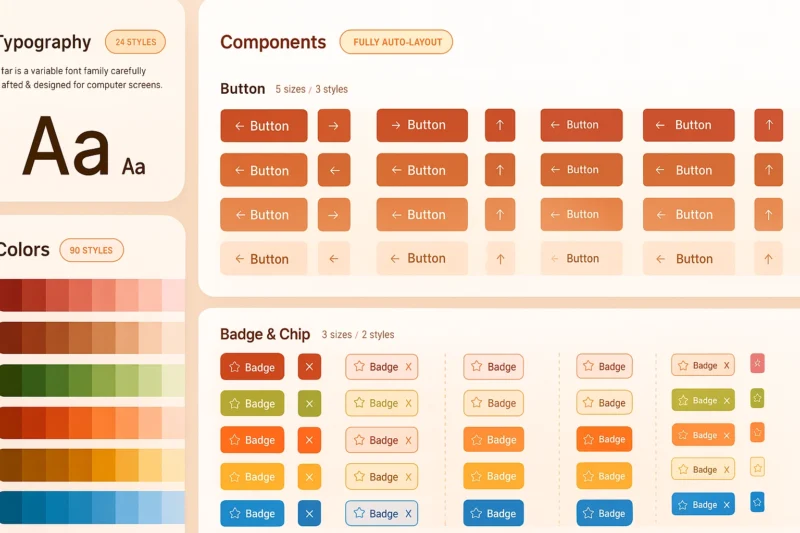Beyond the Buttons: How to Transform Your Design System from Static Library to Cross-Functional Powerhouse

Design systems have evolved from nice-to-have documentation into critical infrastructure that determines whether digital products scale successfully or collapse under their own complexity. For web developers and digital interface designers working in computer systems, the challenge isn’t just building components—it’s architecting collaborative frameworks that accelerate development while maintaining consistency across platforms.
After analyzing approaches from industry leaders managing design systems at scale, several strategic patterns emerge that can transform how technical teams approach this challenge.
The Infrastructure Mindset: Treating Design Systems as Technical Architecture
The most successful design systems share a common characteristic: they’re built like robust technical infrastructure rather than static asset libraries. This infrastructure-first approach manifests in three critical ways.
Automation as the Foundation
Pavel Sher, CEO, FuseBase,, emphasizes that “building a component-based framework with automated workflows cuts right through” cross-functional complexity. His team implemented a system where “design team pushed updates directly into our SaaS dashboard templates, and automation handled syncing changes across interfaces—freeing product managers from tedious checks.”
This approach transforms the fundamental challenge: “Scaling design systems isn’t just about aesthetics; it’s about structuring tools so each team sees consistency as default, not as overhead,” Sher explains. The technical implementation becomes invisible to end users while ensuring systematic reliability.
API-First Architecture
Kevin Baragona, Founder, Deep AI, advocates for an “API-first design system scaling” approach that delivers measurable results. “According to research by Marketo, companies that have implemented design systems have seen an average of 75% reduction in development time and a 50% increase in design consistency,” he notes.
The strategic advantage becomes clear in implementation: “Treating the design system like an API means components can be consumed in multiple platforms without duplication, such as web, mobile, and internal dashboards,” Baragona explains. “Collaboration across frontend and backend teams becomes smoother, reducing misalignment between product experiences by abstracting usage into APIs.”
Building Shared Mental Models Through Cross-Functional Empathy
Technical success requires more than robust architecture—it demands shared understanding across disciplines. Max Shak, Founder/CEO, nerDigital, discovered this through practical experience: “I realized a design system isn’t just about aesthetics—it’s about creating a shared language that allows designers, developers, and even marketers to collaborate without friction.”
Decision Frameworks Over Visual Assets
Raul Reyeszumeta, VP, Product & Design, MarketScale , advocates for a fundamental shift in approach: “Don’t build a library – build shared understanding.” His methodology focuses on decision frameworks rather than visual assets.
“The problem isn’t technical. Teams create components but skip the context,” Reyeszumeta explains. “Developers get a button component with no explanation of when to use primary versus secondary versus destructive states. Designers assume everyone knows the visual hierarchy rules they have in their heads.”
His solution is systematic: “Start with decision frameworks instead of visual assets. Document the ‘why’ before the ‘what.’ When should someone use a destructive action? What constitutes a primary workflow versus a secondary one? Write those rules down first.”
Real-Time Collaboration Eliminates Handoffs
Both Reyeszumeta and Shak emphasize eliminating traditional handoff processes. “For cross-functional collaboration, eliminate the handoff mentality. Design and development shouldn’t be separate phases – they’re the same conversation happening with different tools,” Reyeszumeta states.
Shak’s implementation validates this approach: “One of the most effective shifts we made was pairing designers with developers much earlier in the process. Instead of handing off files at the end, we built a workflow where they collaborated in real time. It cut down on rework and created a stronger sense of trust across teams.”
Product Management Approaches for System Governance
Treating Design Systems as Products
John Beaver, Founder, Desky, advocates for treating design systems “similar to running a product with a team of designers, developers & product managers. Everyone has a designated role.” His framework includes clear metrics: “Your roadmap should have clear objectives such as reducing design handoff time within your workflows by 25% or getting 40% of the teams to use the design system.”
The measurement approach focuses on business impact: “For example, how many teams are using the system? How satisfied are they with the system? How much time does the system save them? Or if your design system saves a team 30% of their development time, then that is a good outcome.”
Living Systems Through Continuous Feedback
Shak emphasizes treating “the design system as a living product, not a static library.” His team established “monthly reviews where cross-functional teams could propose improvements. That practice did two things: it gave everyone a sense of ownership, and it turned the design system into a hub for collaboration instead of a set of rigid rules.”
Complexity Management Strategies
Modular Architecture for Multiple Use Cases
Itamar Haim, SEO Strategist, Elementor demonstrates practical modularity: “scaling design systems works best when SEO, UX, and design teams collaborate with shared templates, so no one has to reinvent the wheel.” His approach enabled rapid delivery: “by building a modular layout, we delivered their idea fast while still keeping performance metrics in check.”
Eric Do Couto, Chief Marketing Officer at Visualping, emphasizes fighting complexity through clarity: “We focus on modular design systems that are simple to maintain, with documentation that product, engineering, and marketing can all understand. This creates a shared language, so cross-functional collaboration isn’t bogged down by translation issues.”
Dual-Speed Implementation
Stefan Van der Vlag, AI Expert/Founder, Clepher, advocates for a “dual-speed approach, where core system evolution happens steadily while feature-specific adaptations evolve quickly, helps balance innovation and stability.” Research supports this approach: “According to research by McKinsey, dual-speed IT is one of the most effective ways to optimize digital transformation projects. They found that organizations that adopt this approach experience a 70% increase in speed to market while also reducing costs by 20-30%.”
Practical Implementation for Small to Medium Teams
Developer-Designer Collaboration
Rohit Agarwal, Co-Founder, Zenius, shares insights from building systems without existing infrastructure: “We quickly realised that having a library full of components is no use if those designs cannot be translated into code and put to use.” His solution emphasizes tight collaboration: “designers at Zenius collaborated closely with our frontend developers to ensure that these elements were ready to implement ASAP.”
The key success factor was timing: “We prioritized quick turnaround times and feedback. So, for example, the frontend team wouldn’t raise objections to an element or icon’s design weeks after the design team finalized it.”
Creative Problem-Solving Approaches
George Fironov, Co-Founder & CEO, Talmatic, introduces innovative collaboration methods: “organizing remote hackathons focused on solving internal workflow problems, which not only promotes collaboration across departments but also generates practical solutions that improve our daily operations.” This approach “naturally build relationships between team members with different expertise while giving employees greater ownership over process improvements.”
Key Strategic Takeaways
The most successful design systems combine technical architecture with human-centered collaboration processes. As Reyeszumeta concludes: “Most teams focus on consistency in appearance. Focus on consistency in reasoning. When the whole team understands the logic behind design decisions, they can make the right choices without checking documentation.”
Shak reinforces this with a human-centered perspective: “design systems thrive when they’re rooted in cross-functional empathy. You’re not just documenting colors and buttons; you’re creating a framework that respects how different teams work and what they need to succeed.”
For web developers and digital interface designers, the strategic imperative is clear: build systems that teach and enable rather than simply standardize. The technical infrastructure must support human collaboration, and the collaborative processes must respect technical constraints. When both elements align, design systems become force multipliers for digital product development at scale.









